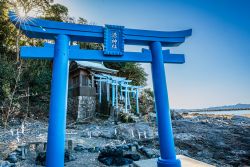
December 9, 2010
Xishuangbanna
Borderland China offers a fertile mix of nature and ethnicities
By Metropolis
Originally published on metropolis.co.jp on December 2010

Photos by Stephen Mansfield


Crossing into the eastern reaches of Yunnan Province, travel writer Simon Winchester observed, “Ahead of us now, lay the very much wayward world of the non-Chinese, the world of those who have been incorporated into the Chinese Empire, but who live irredeemably and steadfastly beyond it.”
Lying even further beyond the new Chinese empire, in the deep recesses of Yunnan, is a region known as Xishuangbanna. It is here that the influences of a more monolithic China subdivide and dissolve into the rich ethnic morass of Southeast Asia’s wild frontier land.
With borders facing Vietnam, Burma and Laos, its two seasons limited to wet and dry, and 25 listed ethnic minorities, this southwestern county of Yunnan is also the conduit through which the Mekong, Salween and Red rivers flow—waterways that are strongly associated with Southeast Asia and the countries of Indochina.
The first thing most visitors remark on as they step off the plane at the airport just outside of Jinghong, the regional capital, or its crowded bus terminal, is the air’s bewildering mix of blossom and building dust, the impression of having entered an embattled botanical garden. Easier access to Xishuangbanna with improved air and road systems has brought more tourism to the capital, and a corresponding level of environmental damage. With increased logging and the removal of forest resources, hill tribes are being stripped of the protective cover on which they have relied for centuries, and forced down onto the plains where they have to settle and cultivate rice.
Despite the threat of cultural oblivion, few places in Asia reveal such a complex and bewildering ethnic and linguistic macramé as the remote valleys, upland slopes and jungles of Xishuangbanna. How, though, do you define a people who are of China, but not precisely Chinese? The answer is to treat them as fully accredited Chinese citizens but to call them Minority Nationalities. Jinghong’s National Minorities Park, though a pastiche of the region’s real ethnicity, is a decent introduction to the ethnology of the region.
Ultimately, it is Xishuangbanna’s more accessible natural flora that most people remember. At the Tropical Crops Research Institute in Jinghong, over 1,000 varieties of plants are laid out against flowerbeds, lawns and lakes. Here you can learn what miracle fruit looks like, how rubber is tapped, and what ingredients go into the making of chocolate. Familiar products such as pepper, cinnamon, sesame and nutmeg are cultivated alongside camellias, azaleas, magnolia and many other flowers native to Yunnan.
For a look at the deeper roots of horticulture, the Tropical Botanical Garden at Menglun contains one of the largest concentrations of tropical plants and trees in the world. Sitting on an island at a bend of the Luosuo River, the garden was founded in 1958 by well-known Chinese botanist Cai Xitao and a group of local Dai and Yao ethnic minority members, who helped to collect rare specimens. In the process, they discovered new plants and flowers.
There are 500 people engaged in research here, not to mention an army of gardeners whose job it is to maintain over 3,000 different species of plants. As you enter into the depths of the garden, giant palms and banyan trees block out the sun. Camphor and sandalwood trees fill the air with a heady perfume, while orchids and other exotic flowers take root on the branches and in the crevices of vines and creepers.
A showcase for the rich and colorful fertility of Xishuangbanna—and the diversity of its ethnic groups—can be seen in Ganlanba, a huge agricultural area better known as the Olive Plain. Visitors spend their time walking or cycling between villages, or following routes past groves of coconut palms, rice paddies, fruit orchards, rubber plantations and the
occasional tea field.
Deep in this singular corner of China, amid a broad cross-section of ethnic groups and stunningly fertile farms, visitors will feel they are surveying not only a parkland of flowers, plants and tropical fruits, but a rich human terrain.
Trip Tips
 There are flights to Jinghong airport from Kunming and other cities in China. The long-distance bus ride from Kunming can take up to 24 hours. Buses and minibuses depart for destinations around Xishuangbanna from bus station number 2. The dry months from November-March are the ideal time to visit. The Banna Hotel on Galan Zhong Lu has moderately priced, garden-facing rooms. Backpackers favor the friendly Dai Garden Building on Manting Lu. The only guide to the region is Bradt’s China: Yunnan Province.
There are flights to Jinghong airport from Kunming and other cities in China. The long-distance bus ride from Kunming can take up to 24 hours. Buses and minibuses depart for destinations around Xishuangbanna from bus station number 2. The dry months from November-March are the ideal time to visit. The Banna Hotel on Galan Zhong Lu has moderately priced, garden-facing rooms. Backpackers favor the friendly Dai Garden Building on Manting Lu. The only guide to the region is Bradt’s China: Yunnan Province.







